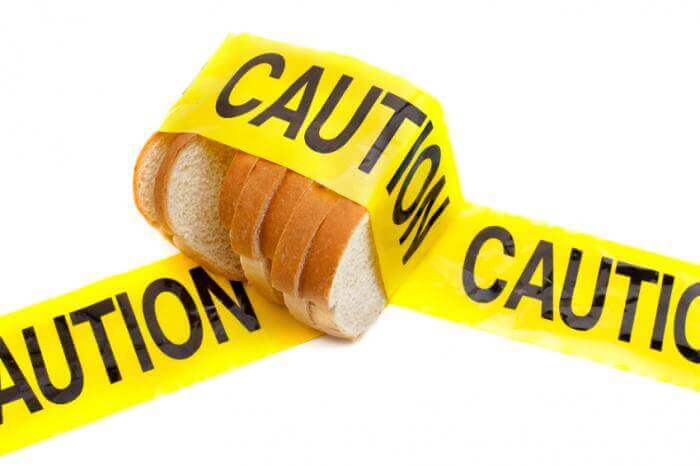Symptoms of Gluten Intolerance in Children

The symptoms of gluten intolerance can be digestive or otherwise. They vary according to age and aren’t the same in all children. It’s important to be familiar with the symptoms in order to make a correct diagnosis as early as possible. Because of this, we’d like to go through the different symptoms which can help you know if your child is gluten intolerant.
Gluten intolerance in children
Gluten intolerance or celiac disease is an immune reaction to gluten, a protein found in wheat, barley and rye. Over time, this reaction damages the lining of the small intestine and prevents the absorption of some nutrients.
In children, gastrointestinal symptoms usually occur between 6 and 24 months, once gluten is introduced into the diet. The most typical symptoms are nausea, vomiting, diarrhea, low weight, growth problems, among others. We’ll now take a look at these symptoms in more detail.

Symptoms related to digestion
Perhaps the most significant evidence that can show that a child is gluten intolerant has to do with the digestive system. Here are some of the most common symptoms in this regard:
- Frequent swelling of the belly
- Nausea that ends in vomiting
- The stools, in addition to being smelly, are also whitish in color
- Frequent constipation or diarrhea
- The child complains of bloating in his stomach
- The child will also complain of stomach ache
- Your child has a lack of appetite
Symptoms relating to growth
Other symptoms that may show that children are gluten intolerant is when they don’t grow as quickly as other children of the same age, both in height and weight.
In children under two years of age, progressive muscular atrophy can occur and, if children are diagnosed when they’re over two, they could experience puberty later than other children.
Behavioral symptoms
Apart from the physical symptoms, there are also signs in children’s behavior that they may be gluten intolerant. These could be:
- Sudden changes in mood
- Irritability
- Hyperactivity
- Apathy
- Dyslexia
- Autism
Other manifestations of gluten intolerance in children
Iron deficiency anemia
This is the most common symptom in celiacs. This occurs due to damage to the intestine, which causes it not to absorb nutrients, leading to deficiencies in certain substances.
Iron is the most common deficiency. Calcium, vitamin D and potassium deficiencies also occur, and this causes children to have lower bone mineral density.
Herpetiformis dermatitis
Herpetiformis dermatitis is the manifestation of celiac disease on the skin. This is a skin disease that causes itching and blisters, and that originates from intestinal gluten intolerance. The rash usually appears on the elbows, knees, torso, scalp and buttocks.
Usually, herpetiformis dermatitis is linked to changes identical to those of celiac disease in the walls of the small intestine, but this dermatitis doesn’t always produce obvious digestive symptoms.
Cold sores
Cold sores are a quite frequent, but not well-known, symptom of gluten intolerance. Sometimes called canker sores, these are circle-shaped lesions that have a slight swelling and usually occur in the gums, inner cheeks and under the tongue.

Groups at risk of gluten intolerance
Although any child can suffer from this intolerance, there are certain risk groups, such as:
- Direct relatives with celiac disease
- Children with type 1 diabetes
- Children with Down syndrome
The disease affects caucasian people more than any other group. It’s also more frequent in women than in men, and is hereditary.
Gluten intolerance is 5 times higher in children than in adults. Currently, it isn’t possible to prevent this disease and the only treatment is to remove gluten from the child’s diet.
If your child has some, or several, of these symptoms, then go to the doctor for a diagnosis. If the diagnosis is positive then a nutritionist will give you guidelines about how to keep a gluten-free diet.
Here’s another article that we’re sure you’ll find helpful:
The symptoms of gluten intolerance can be digestive or otherwise. They vary according to age and aren’t the same in all children. It’s important to be familiar with the symptoms in order to make a correct diagnosis as early as possible. Because of this, we’d like to go through the different symptoms which can help you know if your child is gluten intolerant.
Gluten intolerance in children
Gluten intolerance or celiac disease is an immune reaction to gluten, a protein found in wheat, barley and rye. Over time, this reaction damages the lining of the small intestine and prevents the absorption of some nutrients.
In children, gastrointestinal symptoms usually occur between 6 and 24 months, once gluten is introduced into the diet. The most typical symptoms are nausea, vomiting, diarrhea, low weight, growth problems, among others. We’ll now take a look at these symptoms in more detail.

Symptoms related to digestion
Perhaps the most significant evidence that can show that a child is gluten intolerant has to do with the digestive system. Here are some of the most common symptoms in this regard:
- Frequent swelling of the belly
- Nausea that ends in vomiting
- The stools, in addition to being smelly, are also whitish in color
- Frequent constipation or diarrhea
- The child complains of bloating in his stomach
- The child will also complain of stomach ache
- Your child has a lack of appetite
Symptoms relating to growth
Other symptoms that may show that children are gluten intolerant is when they don’t grow as quickly as other children of the same age, both in height and weight.
In children under two years of age, progressive muscular atrophy can occur and, if children are diagnosed when they’re over two, they could experience puberty later than other children.
Behavioral symptoms
Apart from the physical symptoms, there are also signs in children’s behavior that they may be gluten intolerant. These could be:
- Sudden changes in mood
- Irritability
- Hyperactivity
- Apathy
- Dyslexia
- Autism
Other manifestations of gluten intolerance in children
Iron deficiency anemia
This is the most common symptom in celiacs. This occurs due to damage to the intestine, which causes it not to absorb nutrients, leading to deficiencies in certain substances.
Iron is the most common deficiency. Calcium, vitamin D and potassium deficiencies also occur, and this causes children to have lower bone mineral density.
Herpetiformis dermatitis
Herpetiformis dermatitis is the manifestation of celiac disease on the skin. This is a skin disease that causes itching and blisters, and that originates from intestinal gluten intolerance. The rash usually appears on the elbows, knees, torso, scalp and buttocks.
Usually, herpetiformis dermatitis is linked to changes identical to those of celiac disease in the walls of the small intestine, but this dermatitis doesn’t always produce obvious digestive symptoms.
Cold sores
Cold sores are a quite frequent, but not well-known, symptom of gluten intolerance. Sometimes called canker sores, these are circle-shaped lesions that have a slight swelling and usually occur in the gums, inner cheeks and under the tongue.

Groups at risk of gluten intolerance
Although any child can suffer from this intolerance, there are certain risk groups, such as:
- Direct relatives with celiac disease
- Children with type 1 diabetes
- Children with Down syndrome
The disease affects caucasian people more than any other group. It’s also more frequent in women than in men, and is hereditary.
Gluten intolerance is 5 times higher in children than in adults. Currently, it isn’t possible to prevent this disease and the only treatment is to remove gluten from the child’s diet.
If your child has some, or several, of these symptoms, then go to the doctor for a diagnosis. If the diagnosis is positive then a nutritionist will give you guidelines about how to keep a gluten-free diet.
Here’s another article that we’re sure you’ll find helpful:
All cited sources were thoroughly reviewed by our team to ensure their quality, reliability, currency, and validity. The bibliography of this article was considered reliable and of academic or scientific accuracy.
- Leonard MM., Sapone A., Catassi C., Fasano A., Celiac disease and nonceliac gluten sensitivity: a review. JAMA, 2017. 318 (7): 647-656.
- Ahlawat, Rajni, Toba Weinstein, and Michael J. Pettei. (2017). “Vitamin D in pediatric gastrointestinal disease.” Current opinion in pediatrics 29.1 (2017): 122-127.
- Sharr, Christianne, et al. (2016). “Detecting celiac disease in patients with Down syndrome.” American Journal of Medical Genetics Part A 170.12: 3098-3105.
This text is provided for informational purposes only and does not replace consultation with a professional. If in doubt, consult your specialist.








